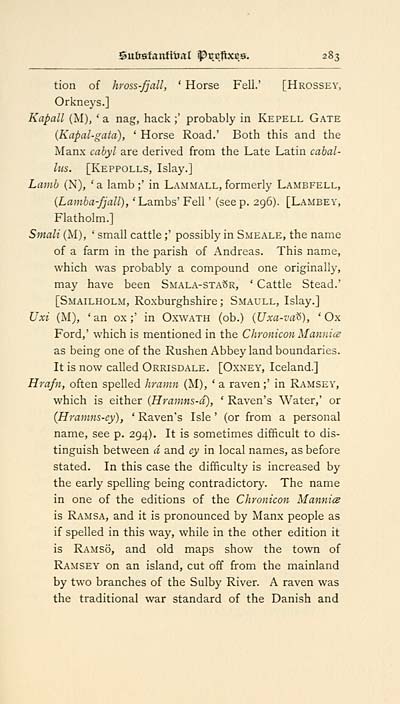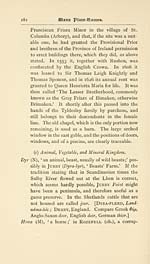Download files
Complete book:
Individual page:
Thumbnail gallery: Grid view | List view

SubsfantiiJat ^ttc.tixBs. 283
tion of hross-fjall, ' Horse Fell.' [Hrossey,
Orkneys.]
Kapall (M), * a nag, hack ;' probably in Kepell Gate
{Kapal-gata), ' Horse Road.' Both this and the
Manx cahyl are derived from the Late Latin cabal-
lus. [Keppolls, Islay.]
Lamb (N), ' a lamb ;' in Lammall, formerly Lambfell,
{Lamha-fjall), 'Lambs' Fell ' (seep. 296). [Lambey,
Flatholm.]
Smali (M), ' small cattle ;' possibly in Smeale, the name
of a farm in the parish of Andreas. This name,
which was probably a compound one originally,
may have been Smala-staSr, ' Cattle Stead.'
[Smailholm, Roxburghshire; Smaull, Islay.]
Uxi (M), 'an ox;' in Oxwath (ob.) (Uxa-va'Si), 'Ox
Ford,' which is mentioned in the Chronicon Mannice
as being one of the Rushen Abbey land boundaries.
It is now called Orrisdale. [Oxney, Iceland.]
Hrafn, often spelled hramn (M), ' a raven ;' in Ramsey,
which is either (Hramns-d), ' Raven's Water,' or
(Hramns-ey), ' Raven's Isle ' (or from a personal
name, see p. 294). It is sometimes difficult to dis-
tinguish between a and ey in local names, as before
stated. In this case the difficulty is increased by
the early spelling being contradictory. The name
in one of the editions of the Chyonicon Mannics
is Ramsa, and it is pronounced by Manx people as
if spelled in this way, while in the other edition it
is Ramso, and old maps show the town of
Ramsey on an island, cut off from the mainland
by two branches of the Sulby River. A raven was
the traditional war standard of the Danish and
tion of hross-fjall, ' Horse Fell.' [Hrossey,
Orkneys.]
Kapall (M), * a nag, hack ;' probably in Kepell Gate
{Kapal-gata), ' Horse Road.' Both this and the
Manx cahyl are derived from the Late Latin cabal-
lus. [Keppolls, Islay.]
Lamb (N), ' a lamb ;' in Lammall, formerly Lambfell,
{Lamha-fjall), 'Lambs' Fell ' (seep. 296). [Lambey,
Flatholm.]
Smali (M), ' small cattle ;' possibly in Smeale, the name
of a farm in the parish of Andreas. This name,
which was probably a compound one originally,
may have been Smala-staSr, ' Cattle Stead.'
[Smailholm, Roxburghshire; Smaull, Islay.]
Uxi (M), 'an ox;' in Oxwath (ob.) (Uxa-va'Si), 'Ox
Ford,' which is mentioned in the Chronicon Mannice
as being one of the Rushen Abbey land boundaries.
It is now called Orrisdale. [Oxney, Iceland.]
Hrafn, often spelled hramn (M), ' a raven ;' in Ramsey,
which is either (Hramns-d), ' Raven's Water,' or
(Hramns-ey), ' Raven's Isle ' (or from a personal
name, see p. 294). It is sometimes difficult to dis-
tinguish between a and ey in local names, as before
stated. In this case the difficulty is increased by
the early spelling being contradictory. The name
in one of the editions of the Chyonicon Mannics
is Ramsa, and it is pronounced by Manx people as
if spelled in this way, while in the other edition it
is Ramso, and old maps show the town of
Ramsey on an island, cut off from the mainland
by two branches of the Sulby River. A raven was
the traditional war standard of the Danish and
Set display mode to: Large image | Transcription
Images and transcriptions on this page, including medium image downloads, may be used under the Creative Commons Attribution 4.0 International Licence unless otherwise stated. ![]()
| Early Gaelic Book Collections > Blair Collection > Surnames & place-names of the Isle of Man > (301) |
|---|
| Permanent URL | https://digital.nls.uk/82103260 |
|---|
| Description | A selection of books from a collection of more than 500 titles, mostly on religious and literary topics. Also includes some material dealing with other Celtic languages and societies. Collection created towards the end of the 19th century by Lady Evelyn Stewart Murray. |
|---|
| Description | Selected items from five 'Special and Named Printed Collections'. Includes books in Gaelic and other Celtic languages, works about the Gaels, their languages, literature, culture and history. |
|---|

